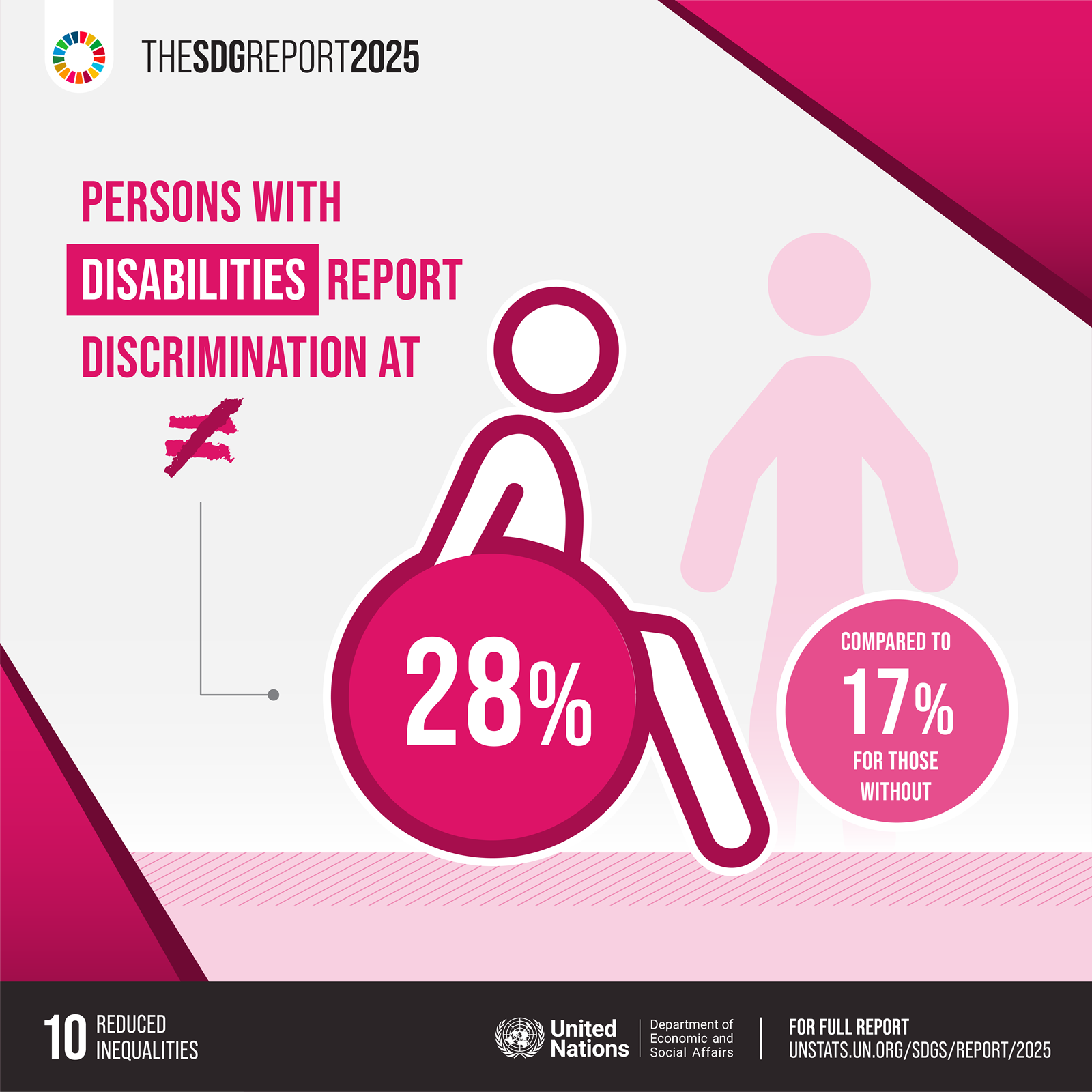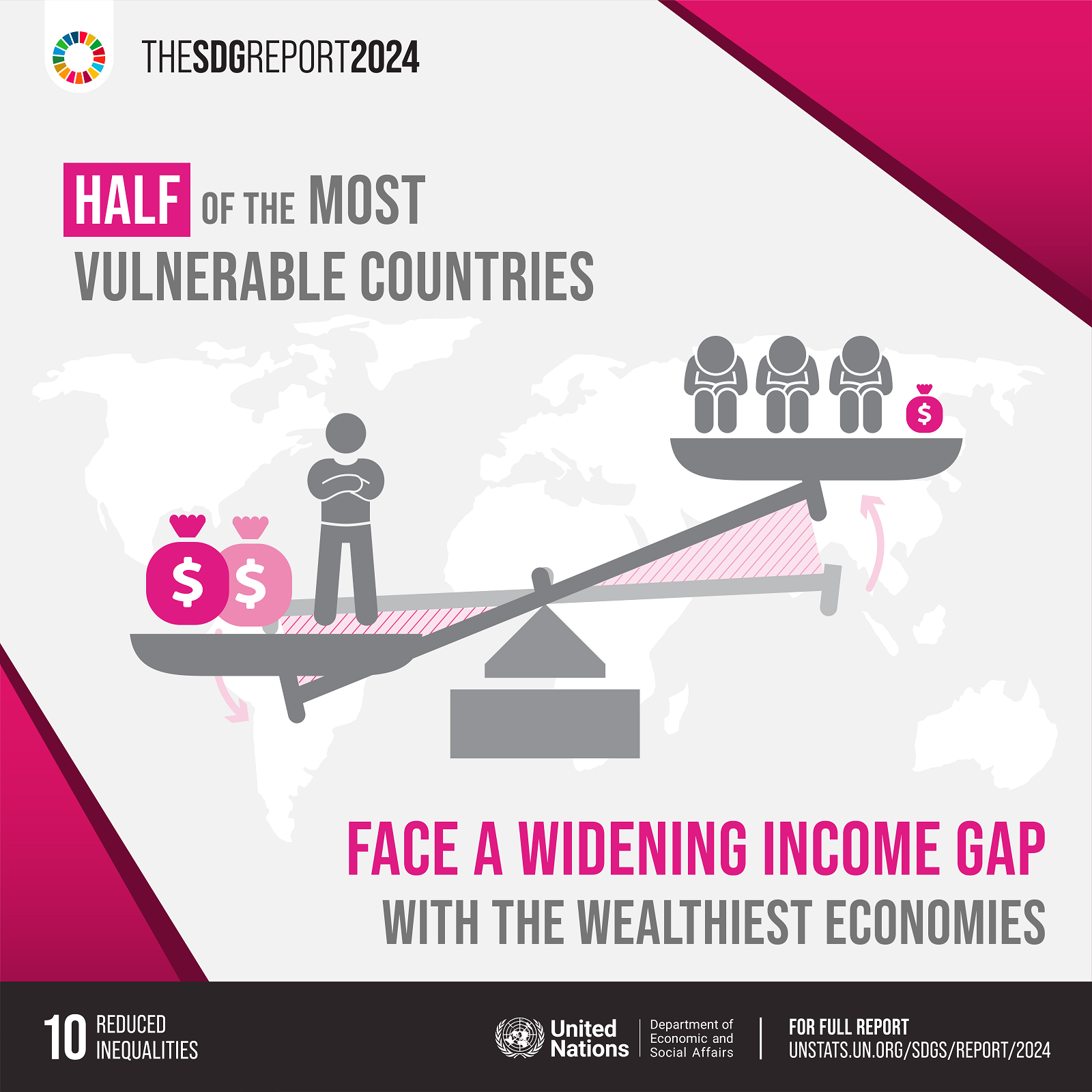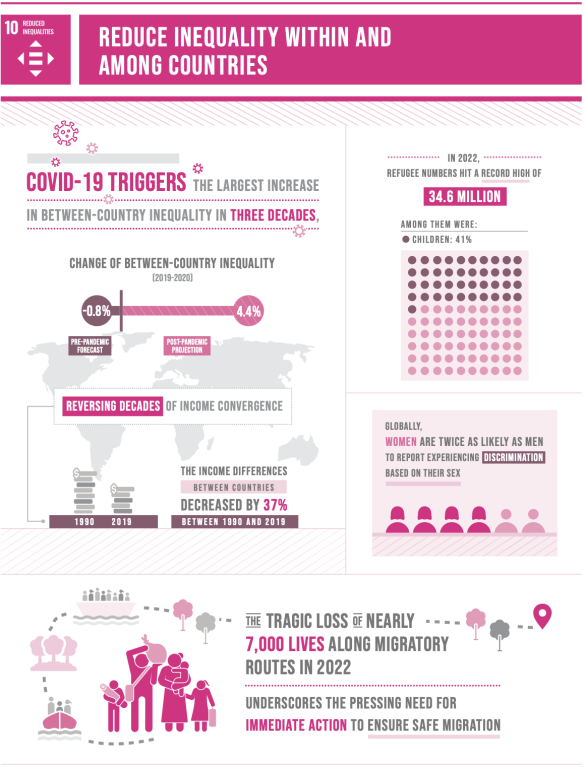Overview
Targets and Indicators

10.1
By 2030, progressively achieve and sustain income growth of the bottom 40 per cent of the population at a rate higher than the national average
10.1.1
Growth rates of household expenditure or income per capita among the bottom 40 per cent of the population and the total population

10.2
By 2030, empower and promote the social, economic and political inclusion of all, irrespective of age, sex, disability, race, ethnicity, origin, religion or economic or other status
10.2.1
Proportion of people living below 50 per cent of median income, by sex, age and persons with disabilities

10.3
Ensure equal opportunity and reduce inequalities of outcome, including by eliminating discriminatory laws, policies and practices and promoting appropriate legislation, policies and action in this regard
10.3.1
Proportion of population reporting having personally felt discriminated against or harassed within the previous 12 months on the basis of a ground of discrimination prohibited under international human rights law

10.4
Adopt policies, especially fiscal, wage and social protection policies, and progressively achieve greater equality
10.4.1
Labour share of GDP
10.4.2
Redistributive impact of fiscal policy on the Gini index

10.5
Improve the regulation and monitoring of global financial markets and institutions and strengthen the implementation of such regulations
10.5.1
Financial Soundness Indicators

10.6
Ensure enhanced representation and voice for developing countries in decision-making in global international economic and financial institutions in order to deliver more effective, credible, accountable and legitimate institutions
10.6.1
Proportion of members and voting rights of developing countries in international organizations

10.7
Facilitate orderly, safe, regular and responsible migration and mobility of people, including through the implementation of planned and well-managed migration policies
10.7.1
Recruitment cost borne by employee as a proportion of montlhy income earned in country of destination
10.7.2
Number of countries with migration policies that facilitate orderly, safe, regular and responsible migration and mobility of people
10.7.3
Number of people who died or disappeared in the process of migration towards an international destination
10.7.4
Proportion of the population who are refugees, by country of origin

10.a
Implement the principle of special and differential treatment for developing countries, in particular least developed countries, in accordance with World Trade Organization agreements
10.a.1
Proportion of tariff lines applied to imports from least developed countries and developing countries with zero-tariff

10.b
Encourage official development assistance and financial flows, including foreign direct investment, to States where the need is greatest, in particular least developed countries, African countries, small island developing States and landlocked developing countries, in accordance with their national plans and programmes
10.b.1
Total resource flows for development (e.g. official development assistance, foreign direct investment and other flows)

10.c
By 2030, reduce to less than 3 per cent the transaction costs of migrant remittances and eliminate remittance corridors with costs higher than 5 per cent
10.c.1
Remittance costs as a proportion of the amount remitted
Progress and Info
The global economy shows contrasting dynamics, with a resilient banking sector and declining labour income worsening inequality. While most countries have seen pro-poor growth, 12 per cent still live below 50 per cent of median income, with Latin America and the Caribbean most affected. Meanwhile, the refugee population has surged to 37.8 million, mainly from Afghanistan, the Syrian Arab Republic, Ukraine and Venezuela (Bolivarian Republic of), worsening the humanitarian crisis. Rising remittance costs further strain migrant workers, highlighting the need for policies to boost labour income, support refugees and enhance financial resilience for inclusive growth. The United Nations is tackling inequality through initiatives including the Social Protection Floors Recommendation, 2012 (No. 202), of the International Labour Organization, which promotes universal social protection. The United Nations Disability Inclusion Strategy ensures that the United Nations is fully equipped to address the rights and needs of persons with disabilities across all aspects of its work.
Target 10.1 - More than half of the 108 countries with available data have managed to achieve higher income growth among the bottom 40 per cent of the population than the national average. Significant regional differences exist, however, with countries in Eastern and South-Eastern Asia, Europe and Northern America managing to ensure the most pro-poor growth on average.
Target 10.2 - Two thirds of the 128 countries with available data have reduced the proportion of people living below 50 per cent of median income since 2000. Nonetheless, on average 12 per cent of the population lives below this threshold. Following COVID-19, this proportion decreased further in most regions. Regional differences are substantial, with inequality highest in Latin America and the Caribbean, where on average almost 1 in 5 people live below 50 per cent of the median income of their country.
Target 10.4 - In 2024, the global labour income share in GDP decreased to 52.3 per cent, down from 52.9 per cent in 2015, representing a loss of $255 (purchasing power parity) per worker on average. This decline, which impacts lower-income workers the most, contributes to rising inequality.
Target 10.7 - As at mid-2024, the global refugee population under the mandate of the Office of the United Nations High Commissioner for Refugees, including persons in refugee-like situations and other people in need of international protection, reached 37.8 million. Two thirds originate from just four countries – Afghanistan, the Syrian Arab Republic, Ukraine and Venezuela (Bolivarian Republic of). Refugee density stood at 460 per 100,000 people worldwide, more than double the 2015 figure and triple the 2005 ratio.
Target 10.c - In the second quarter of 2024, the cost of sending $200 increased globally. Contributing factors to the increase in remittance costs included major remittance-source economies showing above-average increases and higher foreign-exchange margins in certain corridors.

For more information, please visit: https://unstats.un.org/sdgs/report/2025/
More details on SDG 10 in 2025: https://unstats.un.org/sdgs/report/2025/Goal-10/
The 2025 Extended Report on SDG 10 can be found here: https://unstats.un.org/sdgs/report/2025/extended-report/Extended-Report-2025_Goal-10.pdf









